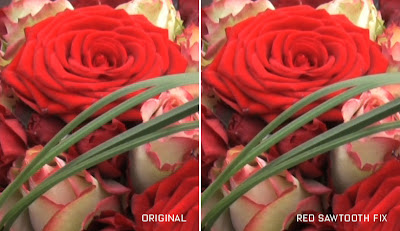
Copy and paste the green text below into a plain text editor
scriptid "Red Sawtooth Fix" //DO NOT LOCALIZE
filter "Red Sawtooth Fix";
group "HF100 Fixes";
// Blurs the V channel in YUV a little bit
InformationFlag("YUVaware")
code
float colorSpace;
colorSpace = kFormatYUV219;
BlurChannel(src1, dest, 0/renderres, 1, 0, 0, 0, aspectof(dest));
BlurChannel(src1, dest, 0/renderres, 0, 1, 0, 0, aspectof(dest));
BlurChannel(src1, dest, 0/renderres, 0, 0, 1, 0, aspectof(dest));
BlurChannel(src1, dest, 1/renderres, 0, 0, 0, 1, aspectof(dest));
Save the text file as Red Sawtooth Fix.txt in
/Library/Application Support/Final Cut Support/Plugins if you use Final Cut Express or
/Library/Application Support/Final Cut Pro System Support/Plugins if you use Final Cut Pro
Restart Final Cut Pro or Express and look for the filter in the "HF100 Fixes" folder under the Video Filters menu
Apply the filter to any HF100 clip with red color in it and enjoy smoother reds.


